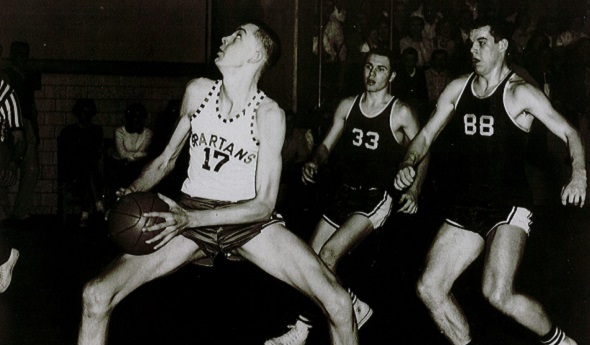
#TBT: Sticks’ Record 50 Still Stands
April 10, 2014
By Geoff Kimmerly
Second Half editor
Last month marked the 58th anniversary of the longest-standing individual record in MHSAA Basketball Finals history.
In 1956, Battle Creek Lakeview center Bob “Sticks” Bolton scored 50 points in a Quarterfinal against Kalamazoo State High School. His points remain the most scored during the final round of the tournament – Quarterfinal-Semifinal-Final.
What follows are edited excerpts from a piece in the MHSAA archives written by former Battle Creek Enquirer reporter Allen Palmeri:
The date was March 21, 1956, and seating capacity in the Hastings High School gymnasium had been expanded to 2,000 this Wednesday night in anticipation of a marvelous Class B Quarterfinal basketball game between two sizzling teams.
New bleachers beckoned behind both goals as Battle Creek Lakeview, 18-2 with a 16-game winning streak, prepared to battle Kalamazoo State High, 19-2 with a 17-game winning streak.
The bleachers weren’t sufficient. About 2,500 fans were able to shoehorn their way in, ringing the court and leaving others in the school’s hallways and out on the sidewalk as one of the most spectacular individual efforts in MHSAA Boys Basketball Tournament history was about to unfold.
In one corner was Lakeview center Bob “Sticks” Bolton, a 6-9 rod of fury. In the other corner was State High’s mountain range of a front line, with peaks standing 6-6, 6-6 and 6-5.
“We looked forward to the game with quite confidence, because we really respected them for the tremendous team they had,” Bolton recalled in 1996. “We knew it was going to be a battle royale because of their size.”
The game within a game of one-on-three was no contest as Bolton simply pulverized the peaks. He poured in 50 points in a 90-73 Lakeview victory, setting a final round record for single game scoring that has withstood decades of assaults by the likes of Ralph Simpson, Spencer Haywood, Earvin Johnson, Jay and Sam Vincent, Antoine Joubert, Jay Smith, Mark Brown and Chris Webber.
***
(He scored) 12, 20, 10 and 8 points through four quarters against State High. He was particularly impressive in the second quarter, when he wound up scoring 20 of his team’s 21 points. Overall, he sank 17 of 27 shots from the field and 16 of 20 from the free throw line.
Though State High took the brunt of Bolton’s blows during the tournament, his effort throughout Lakeview’s run was just as spectacular. ... When Marshall tried to stall away the district opener, Bolton had to settle for 18 points in 40-20 victory. In an 80-58 win over Albion for the district championship, he punched in with a 34-point effort.
In carrying Lakeview to its first regional title, Bolton went ballistic, pumping in 42 points against Three Rivers and a school-record 46 points against an East Lansing team coached by Gus Ganakas. He then went out and topped that in the quarterfinal.
In the semifinals two days later, Bolton was whistled to the sideline with 25 points with a little over half the game played, fouling out in a 74-69 loss to eventual champion Stephenson. Opposing center Mel Peterson, who went on to play for Wheaton College and the NBA’s Baltimore Bullets, had scored 21 points when Bolton fouled out.
Though the memory of that game is painful, he fondly recalls his five-game scoring spree as “lifting my game to a higher level as the competition got tougher and tougher. Praise the Lord for that!”
***
Bolton went on to play collegiately at Western Michigan University, where he cracked the 1,000-point barrier, set a school rebounding record and outscored future NBA Hall of Famer Nate Thurmond on two of three occasions. After his college career, in a semi-pro championship game, he managed to outplay another Hall of Fame center, Walt Bellamy.
But his passion for basketball was never the same after high school. His dedication, vigor and enthusiasm gradually shifted towards the ministry.
At the time of this writing, Bolton served in Marquette, as pastor and administrator of Bethesda Baptist Church and Bethesda Baptist School. He died in 2008.
PHOTO: Bob "Sticks" Bolton dropped 46 points on East Lansing in a 1956 Class A Regional championship game. He followed that with a record 50 points in the Quarterfinal.
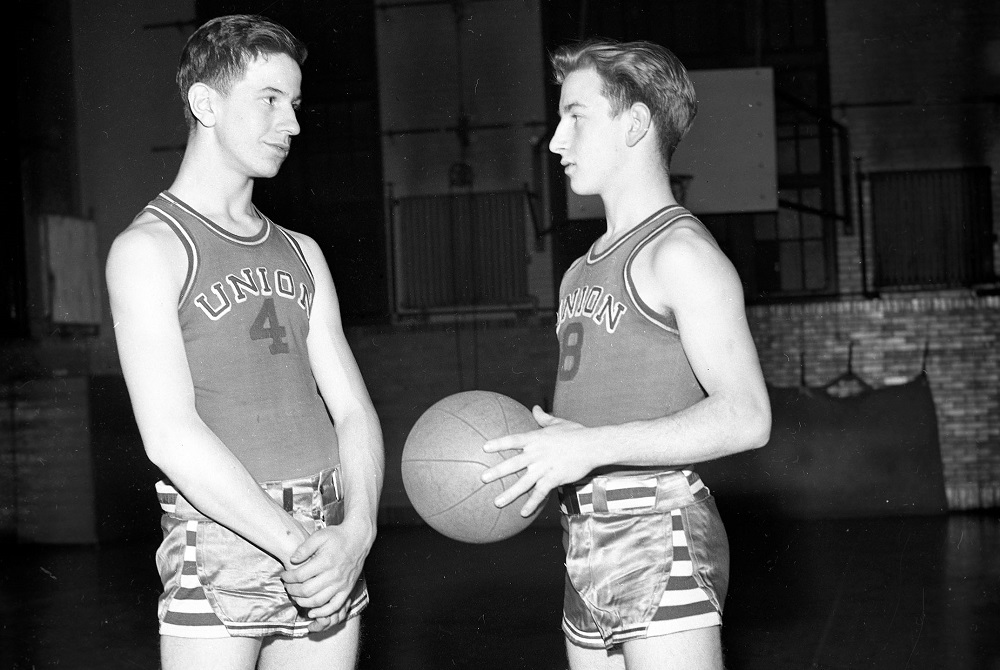
Longtime Coach Researches Photos to Tell Story of Grand Rapids Sports' Past
By
Steve Vedder
Special for MHSAA.com
September 16, 2022
GRAND RAPIDS – Bob Schichtel always pauses when he comes across the ancient black and white photo long enough to ponder whatever became of the two youngsters adorned in Grand Rapids Union basketball uniforms.
The posed shot shows two players facing each other in a local gymnasium in a photo apparently taken four days after the Japanese surprise attack on Pearl Harbor in 1941 that launched the country into World War II. Only a handful of fans today would recognize the players' striped, ultra-short shots and simple sleeveless shirts with "Union" emblazed across the front as recognizable basketball uniforms. One holds a battered-looking basketball, while the other looks on. The two players, whose uniform numbers are "4" and "9," aren't really smiling, but still seem as close as any teammates, whether 81 years ago or today.
In fact, it's the look the youngsters share that intrigues Schichtel, whose thankless, pro bono job it is to identify the two players.
"Once you start," said Schichtel, a former longtime Grand Rapids basketball coach, "it's like looking down a deep rabbit hole."
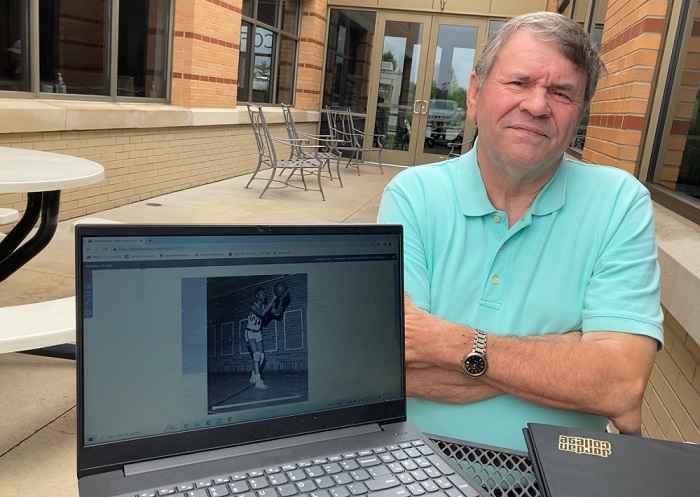 Schichtel works as a volunteer for the Grand Rapids Public Library trying to identify mostly former Grand Rapids City League basketball players from approximately 1938 through the early fifties. The online photos are mostly from the Robinson Photo Studio Collection taken in conjunction with the Grand Rapids Herald newspaper. The library says the unique collection spans some 950 basketball negatives from the entire Robinson/Herald collection that totals well over 900,000 Grand Rapids photos.
Schichtel works as a volunteer for the Grand Rapids Public Library trying to identify mostly former Grand Rapids City League basketball players from approximately 1938 through the early fifties. The online photos are mostly from the Robinson Photo Studio Collection taken in conjunction with the Grand Rapids Herald newspaper. The library says the unique collection spans some 950 basketball negatives from the entire Robinson/Herald collection that totals well over 900,000 Grand Rapids photos.
While the work – which amounts to a ton of patience combined with a detective ability – can be exhausting, it's still what Schichtel describes as a labor of love. For example, there's the shot of the two still-unidentified Union players. Schichtel looks at the photo and can't help but wonder whatever happened to the kids. Were they exceptional athletes? Did they leave their marks on Grand Rapids history, whether it was in education, politics, business, industry, the arts or another field? He doesn't even know, as in many photos from this era, whether the two entered the military and thus even survived World War II.
Schichtel has searched everywhere for the answers, but has come up short. Too many times, in fact.
Which isn't to say he'll quit looking or chalk up his research as inconsequential. Schichtel said the foremost reason he spends hours on the project is that many of the athletes he identifies deserve the recognition for achievements far beyond basketball. In many cases former City League basketball, football, baseball, track and tennis athletes became the foundation on which Grand Rapids was built. If Schichtel can uncover an old photo which depicts these youngsters during their high school careers, so much the better, he said.
"It's important to recognize Grand Rapids sports history, and I don't know if we've given enough attention to their past," Schichtel said. "They are what got us here, and I'm a firm believer they need to be recognized for it."
Figuring out that history, however, ranges from, at the least, extremely time consuming to – in too many frustrating cases – virtually impossible. The City League was formed in the late 1920s and featured original schools Grand Rapids Central, Creston, South, Union, Ottawa Hills, Catholic Central and Davis Tech. The league was eventually folded into the Ottawa-Kent Conference in 2008.
"It was a long, evolving league," Schichtel said.
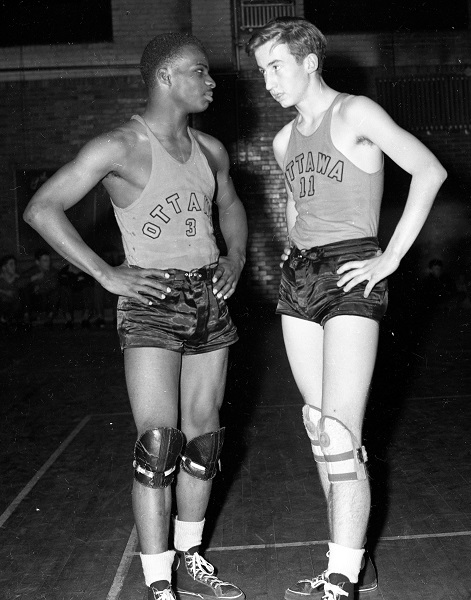 The identification tools available to Schichtel are actually more numerous than most would suspect. For starters, he's formed an impressive database of information by pouring through old City League yearbooks and programs, photos from other collections and microfilm of old newspapers, And then there's also the knowledge gathered by Schichtel himself, a 1968 Grand Rapids Catholic Central graduate. After playing in many old City League gymnasiums, Schichtel went on to compile a 389-197 record in 27 years as the Cougars girls basketball coach. He uses countless City League contacts as both a player and coach to identify athletes. In all, Schichtel taught in the Grand Rapids school system for 34 years.
The identification tools available to Schichtel are actually more numerous than most would suspect. For starters, he's formed an impressive database of information by pouring through old City League yearbooks and programs, photos from other collections and microfilm of old newspapers, And then there's also the knowledge gathered by Schichtel himself, a 1968 Grand Rapids Catholic Central graduate. After playing in many old City League gymnasiums, Schichtel went on to compile a 389-197 record in 27 years as the Cougars girls basketball coach. He uses countless City League contacts as both a player and coach to identify athletes. In all, Schichtel taught in the Grand Rapids school system for 34 years.
He also uses the game itself to identify the photos. For instance, he can pinpoint some photos simply by the styles of the uniforms worn by players. He also figures out who is who by other clues such as what the players are doing in the photo. If a player is taking a set shot in the photo, it's likely pre-World War II. The beginnings of the jump shot, or what Schichtel calls "elevation while shooting," is probably mid-1940s. In addition, Schichtel can identify photos through pure basketball athleticism. Players can look a bit awkward in shots from the thirties as compared to players from the late 1940s who were beginning to play with a more obvious flare.
Put all the information together and Schichtel, who has uncovered more than two dozen personal connections to subjects in the photos, believes he has a reasonable shot at identifying them.
Since he signed on with the project, Schichtel figures he's identified about 10 percent of the photos he's viewed. Among the City League athletes he's found shots of Central's John Lavan, who was born in 1890 and played Major League Baseball during the Babe Ruth era and became a military hero who is buried in Arlington National Cemetery; Creston basketball player Roger Wilkins, an assistant United States attorney general during the Watergate hearings; Art Spoelstra of Godwin, a former NBA player and member of the Grand Rapids Hall of Fame; and Grand Rapids native Bill Cutler, who turned a chance post-World War II meeting with then-American League president Will Harridge into a position as commissioner of the Pacific Coast League,
Schichtel said gaining information through photos on the people who became the bedrock of Grand Rapids should be celebrated.
"I think it's a great approach for the community; they shouldn't be forgotten," Schichtel said. "Who else is going to do this? Why do I do it? I see a certain, for lack of a better word, a nobility. These kids played for the love of game, and they became the “Greatest Generation.” These kids did great things. It's not just, 'Well, there's No. 58,’ in a photo.
"You want to know more about them. That's the real intrigue for me."
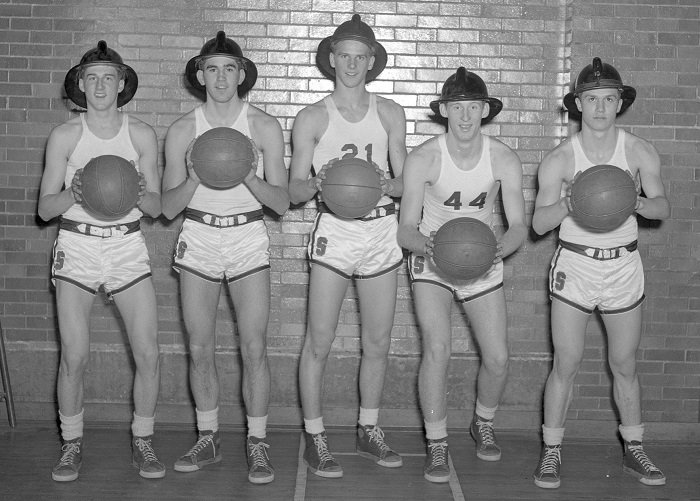 Tim Gloege of the Grand Rapids Public Library said the collection of photos – and their identification – is continually growing. As more people log onto the library's website, more people want to either add to the collection or have information that leads to an identification. The library estimates about 1,200 photos are searched monthly. But as time grows, many of the original photos are disintegrating. The library is in a constant state of preservation, Gloege said.
Tim Gloege of the Grand Rapids Public Library said the collection of photos – and their identification – is continually growing. As more people log onto the library's website, more people want to either add to the collection or have information that leads to an identification. The library estimates about 1,200 photos are searched monthly. But as time grows, many of the original photos are disintegrating. The library is in a constant state of preservation, Gloege said.
"It's a massive project, and we're working to get as many photos online as possible," he said. "The numbers (of photos) we have are rising pretty significantly as people post them on social media.
"When you think of the past and now, you need to realize these are people, kids who used to play basketball and did other things. The work is hard and very time-intensive, but it brings a whole new dimension to history."
Schichtel said he's "kind of picked the low-hanging fruit" on many of the easy photos to identify. But the work will continue.
"Yes, it can be frustrating," he said. "There are limitations if you want it to be accurate. Sometimes you look at a photo and you know it's not going to happen, and you move on. But this a chance to learn about people who made Grand Rapids what it is. That's important to me."
PHOTOS (Top) Two Grand Rapids Union basketball players stand for a photo taken Dec. 12, 1941. (2) Longtime area coach Bob Schichtel researches hundreds of photos that are part of the Grand Rapids Public Library archive. (3) Schichtel has identified these 1941 Grand Rapids Ottawa Hills basketball players as James Horn (left) and Chuch Reynier. (4) Schichtel identified Grand Rapids South High’s “Fireman Five” of, from left, Fred Esslair, Lee Morrow, Jack Carroll, Bob Youngberg and Bruce Bigford. (Historic photos courtesy of the Grand Rapids Public Library.)

